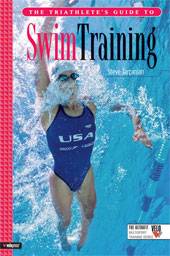Book Review
By Mark Taylor

The Triathlete’s Guide to Swim Training
Author: Steve Tarpinian
Format: Paperback, 171 pages
Publisher: Velo Press (February 10, 2005)
Language: English
ISBN: 1931382573
Book Dimensions: 9.2 x 6.1 x 0.5 inches
Price: US $18.95
The Triathlete’s Guide to Swim Training by Steve Tarpinian is a comprehensive training manual for beginner to advanced swimmers. There is nothing earth shattering for the accomplished swimmer who has received professional instruction from an up to date coach. However, this book is worth a read if your workouts are getting stale, if you are looking to improve your stroke from any level or if you haven’t swum in a while and you want an update on newer swimming techniques. If you are a swim coach this book is a must read.
Free Style is the focus of the book and it hammers in the benefits of drills and pool swimming, even for open water swims. Tarpinian covers everything from proper form, stretching, strength training, the psychology of swimming, to meditation. He even has an appendix with three different training programs targeted for different kinds of races.
My impression is that the author chose breadth of knowledge over depth of knowledge, but he also includes an appendix of other resources. Tarpinian started out as an electrical engineer and it shows in his style even after 20 years of being a swim coach. I appreciate the no nonsense approach of his writing style, there is very little fluff and a lot of data that you can implement right away, especially if you already know how to swim. If you are a new swimmer the concepts in the book may require a more concerted effort on your part.
The book is light on visualizations and body balance concepts but it does cover body rotation, proper position in the water, breathing, how to kick properly and drills, glorious drills. Drills are the strength of this book. Tarpinian culls the ever changing world of swim drills into a basic ten, most of them with flippers and/or small finger paddles to encourage a strong kick and proper body position. My only wish is that the book had the drills as laminated cards so that I could take them to the pool.
Here are some common mindsets that I hear of other triathletes in the pool: “I don’t need to bother with other strokes, I only race using free style”, “why can’t I use a pool buoy all the time? It is like the benefit of my wet suite”, and “Flip turns? I don’t do flip turns in open water, why should I bother to learn?” Well, if you don’t want to dispel these typical misconceptions do not read this book. It extols the benefits of other strokes with helpful points. It also links pool training and flip turns to open swimming, and did I say drills? Buy it for the drills!







